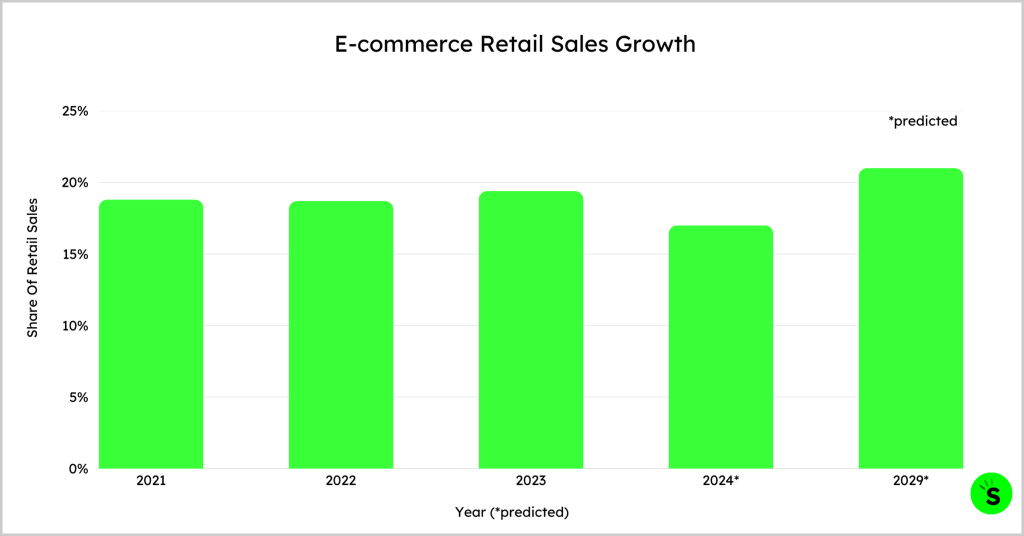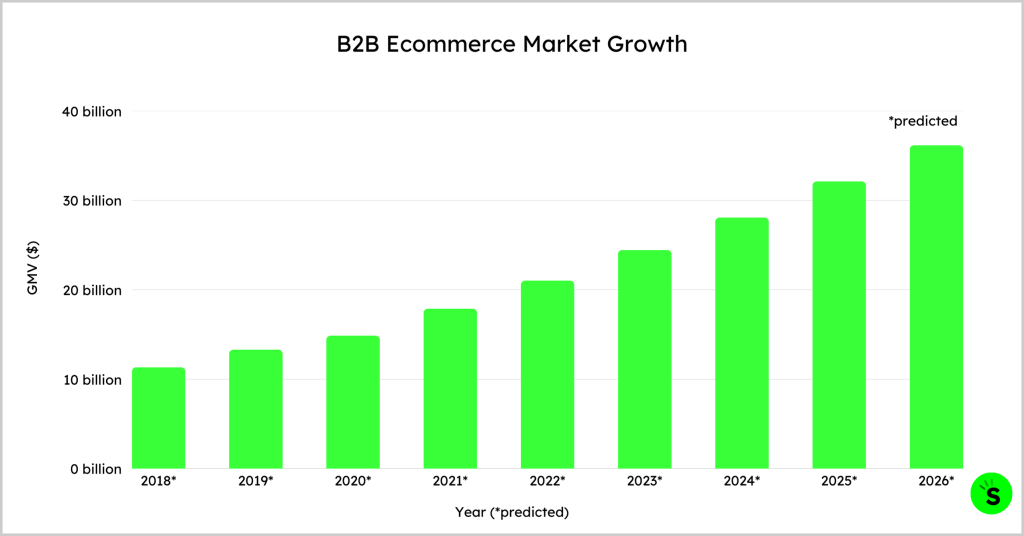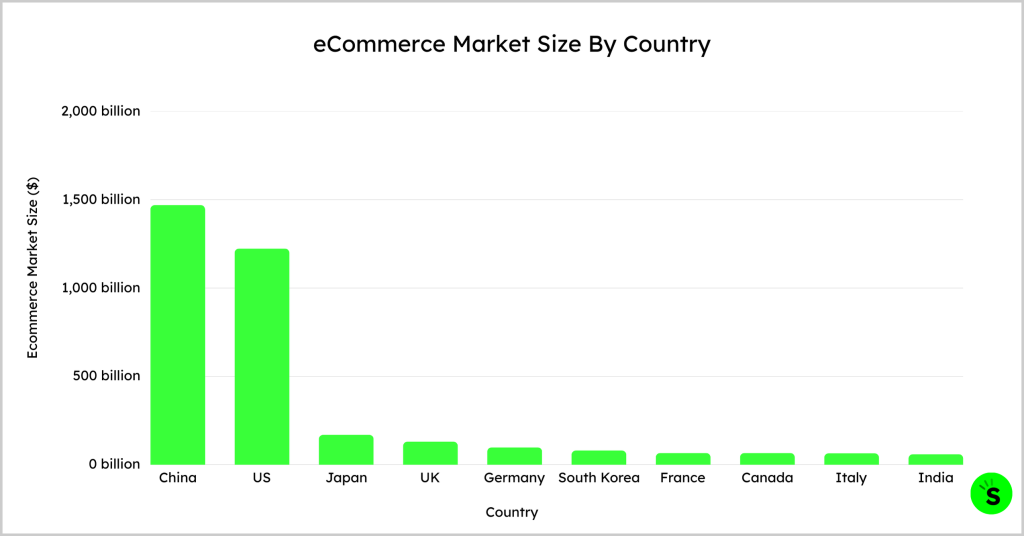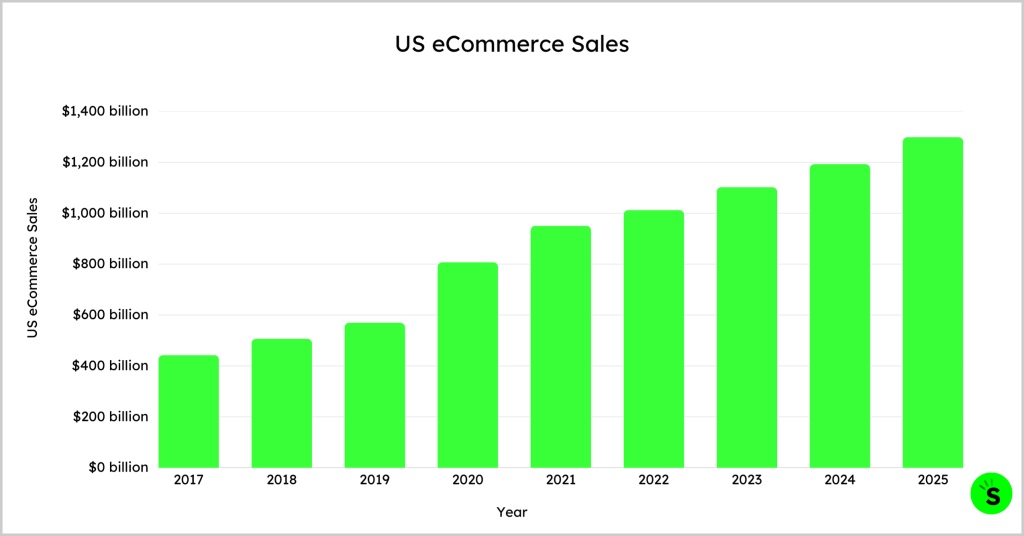The global market is expected to hit $6.56 trillion in 2025, growing at a steady rate of 7.8%. Further, by 2028, worldwide e-commerce sales are projected to soar to around $8.09 trillion.
Besides, in the United States, the e-commerce sales reached $1.19 trillion in 2024, up 8.1% from the year before. This number is expected to rise even higher in 2025, hitting $1.3 trillion.
This article covers the latest eCommerce growth statistics, including the global market size and insights specific to the United States and other countries.
eCommerce Growth Statistics 2025: Key Takeaways
- Global e-commerce sales are projected to grow by 7.8% in 2025.
- The global online shopping market is expected to reach around $6.56 trillion this year.
- In 2024, e-commerce made up 17% of all retail sales worldwide.
- China tops the global e-commerce market, generating a staggering $1.47 trillion in revenue.
- In the U.S., e-commerce sales are projected to reach $1.3 trillion in 2025.
- Back in 2024, online shopping accounted for about 16% of all retail sales in the U.S.
Global E-commerce Sales Growth
Global e-commerce sales are expected to grow by 7.8% in 2025.
As a result, the global e-commerce market is expected to reach $6.56 trillion this year.
The market is projected to grow even further by the end of 2028, reaching around $8.09 trillion.
Here is a table displaying the e-commerce sales growth worldwide by year:
| Year | Global eCommerce Sales | Annual Change |
|---|---|---|
| 2022 | $5.13 trillion | 6.0% |
| 2023 | $5.62 trillion | 9.7% |
| 2024* | $6.09 trillion | 8.4% |
| 2025* | $6.56 trillion | 7.8% |
| 2026* | $7.06 trillion | 7.5% |
| 2027* | $7.57 trillion | 7.2% |
| 2028* | $8.09 trillion | 6.9% |
*- Projected Values
Source: Shopify
Retail e-commerce Sales Worldwide
In 2024, global retail e-commerce sales reached an estimated $6 trillion, according to Statista.
Looking ahead, sales are expected to grow by 31%, reaching around $8 trillion by 2028.
Source: Statista
E-commerce Retail Sales Growth
In 2024, e-commerce made up 17% of total retail sales worldwide.
Further, according to estimates, online sales are likely to make up nearly 21% of global retail sales by 2029.

Here is a table displaying the share of ecommerce sales in total retail sales worldwide:
| Year | Share Of Retail Sales |
|---|---|
| 2029* | 21% |
| 2024 | 17% |
| 2023 | 19.4% |
| 2022 | 18.7% |
| 2021 | 18.8% |
*- projected values
Source: Statista
Global B2B Ecommerce Growth
The global B2B ecommerce market is estimated to grow at a CAGR of 14.5% between 2024 and 2026.
In 2024, the global B2B ecommerce market is estimated to reach $28.082 billion. Comparatively, in 2023, it was valued at $24.453 billion.
Further, by the end of 2026, the market is estimated to be valued at $36.16 billion.

Here is a table displaying the B2B eCommerce market growth by year:
| Year | GMV ($) | Percentage Increase |
|---|---|---|
| 2026* | 36.16 billion | 12.57% |
| 2025* | 32.12 billion | 14.39% |
| 2024* | 28.08 billion | 14.85% |
| 2023 | 24.45 billion | 16.33% |
| 2022 | 21.02 billion | 17.57% |
| 2021 | 17.88 billion | 20.22% |
| 2020 | 14.87 billion | 11.79% |
| 2019 | 13.3 billion | 17.89% |
| 2018 | 11.33 billion | 15.16% |
| 2017 | 9.84 billion | – |
*- projected values
Source: International Trade Administration
eCommerce Market Size By Country
China is the biggest e-commerce market worldwide, with a market revenue of $1.47 trillion.
The United States comes in second with an e-commerce market revenue of $1.22 trillion. Japan is far behind in third place, with $169 billion in e-commerce revenue.

Here is a table displaying the largest e-commerce markets worldwide as of 2024:
| Rank | Country | Ecommerce Market Size ($) |
|---|---|---|
| 1 | China | 1,469 billion |
| 2 | United States | 1,223 billion |
| 3 | Japan | 169 billion |
| 4 | United Kingdom | 130 billion |
| 5 | Germany | 98 billion |
| 6 | South Korea | 80 billion |
| 7 | France | 66 billion |
| 8 | Canada | 66 billion |
| 9 | Italy | 64 billion |
| 10 | India | 59 billion |
Source: Statista
Fastest Growing Retail E-Commerce Market
Turkey is projected to be the fastest-growing eCommerce market globally, with an impressive compound annual growth rate (CAGR) of 11.58% between 2024 and 2029.
Brazil is expected to follow closely behind, growing at an 11.56% CAGR, while India ranks third with an 11.45% CAGR.
Other rapidly expanding eCommerce markets include Mexico, Russia, and Argentina, highlighting the global surge in online shopping across diverse regions.
Here is a table displaying the fastest-growing eCommerce markets worldwide between 2024 to 2029:
| Country | CAGR Between 2024 To 2029 |
|---|---|
| Turkey | 11.58% |
| Brazil | 11.56% |
| India | 11.45% |
| Mexico | 11.26% |
| Russia | 10.95% |
| Argentina | 10.55% |
| South Africa | 10.42% |
| China | 9.95% |
| Italy | 9.94% |
| Canada | 9.76% |
| Spain | 9.72% |
| Indonesia | 9.57% |
Source: Statista
US eCommerce Sales Growth
E-commerce sales in the U.S. are expected to hit $1.3 trillion in 2025, growing by 8.9% from 2024.
Comparatively, in 2024, e-commerce sales in the United States reached $1.19 billion, marking an 8.2% increase from the previous year.

Here is a table displaying the US ecommerce sales and growth recorded over the years:
| Year | US eCommerce Sales | Change From the Previous Year |
|---|---|---|
| 2025 | $1,298.7 billion | +8.9% |
| 2024 | $1,192.6 billion | +8.2% |
| 2023 | $1,102.2 billion | 8.9% |
| 2022 | $1,012.2 billion | 6.5% |
| 2021 | $950.5 billion | 17.8% |
| 2020 | $807.1 billion | 41.7% |
| 2019 | $569.4 billion | 12.4% |
| 2018 | $506.7 billion | 14.5% |
| 2017 | $442.4 billion | 15.4% |
| 2016 | $383.5 billion | 13.7% |
| 2015 | $337.3 billion | 13.6% |
| 2014 | $297.0 billion | 14% |
| 2013 | $260.5 billion | 12.7% |
*- projected values
Source: Sellers Commerce
Quarterly US eCommerce Sales
In the last quarter of 2024, U.S. e-commerce sales hit $352.93 billion, up 2.95% from the previous quarter.
For comparison, sales were $289.04 billion in Q3, $282.62 billion in Q2, and $267.97 billion in Q1 of the same year.
Here is a table displaying the US ecommerce sales by quarter:
| Time | US eCommerce Sales | Change From The Previous Quarter |
|---|---|---|
| Q1 2020 | $154.57 billion | -1.28% |
| Q2 2020 | $203.85 billion | 31.88% |
| Q3 2020 | $201.38 billion | -1.21% |
| Q4 2020 | $199.66 billion | -0.85% |
| Q1 2021 | $234.44 billion | 17.41% |
| Q2 2021 | $241.12 billion | 2.84% |
| Q3 2021 | $240.37 billion | -0.31% |
| Q4 2021 | $244.14 billion | 1.56% |
| Q1 2022 | $252.86 billion | 3.57% |
| Q2 2022 | $258.17 billion | 2.09% |
| Q3 2022 | $264.03 billion | 2.26% |
| Q4 2022 | $264.69 billion | 0.24% |
| Q1 2023 | $266.31 billion | 0.61% |
| Q2 2023 | $272.82 billion | 2.44% |
| Q3 2023 | $279.74 billion | 2.53% |
| Q4 2023 | $283.29 billion | 1.26% |
| Q1 2024 | $287.85 billion | 1.59% |
| Q2 2024 | $291.64 billion | 1.31% |
| Q3 2024 | $289.04 billion | 2.88% |
| Q4 2024 | $352.93 billion | 2.95% |
Source: Sellers Commerce
Share Of eCommerce Sales In Total Retail Sales
In 2024, e-commerce represented 16.04% of the total retail sales in the United States.
In contrast, by the last quarter of 2024, e-commerce sales had risen to 17.9% of the total retail sales in the country. The proportion of e-commerce sales has grown significantly in the U.S. retail market, experiencing an increase of around nine percentage points from 2015 to 2024.
Here is a table displaying the share of e-commerce sales among the retail sales recorded in the United States by year:
| Year | Share of e-commerce Sales In Total Retail Sales |
|---|---|
| 2013 | 5.88% |
| 2014 | 6.53% |
| 2015 | 7.13% |
| 2016 | 7.93% |
| 2017 | 8.78% |
| 2018 | 9.63% |
| 2019 | 10.55% |
| 2020 | 14.53% |
| 2021 | 14.60% |
| 2022 | 14.38% |
| 2023 | 15.30% |
| 2024 | 16.04% |
Source: United States Census Bureau.
More Stats Like This:
Conclusion: The eCommerce Industry is Expected to Grow by 7.8% In 2025
In 2025, worldwide e-commerce sales are projected to reach $6.56 trillion, reflecting a 7.8% increase from the previous year.
Further, by 2027, e-commerce is expected to account for over 20% of global retail sales, highlighting its expanding influence in the retail sector.
Meanwhile, the e-commerce market in the United States is estimated to reach $1.3 trillion in 2025, with growth primarily driven by mobile shopping, the influence of Gen Z consumers, and the expansion of major online retailers like Amazon and Walmart.

